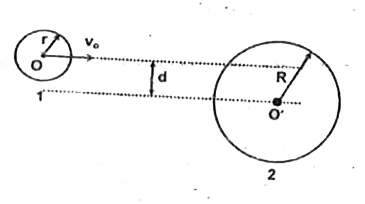A charge "Q" of mass "m" is at rest on a smooth horizontal plane.Another identical particle is projected with a velocity v towards it from long distance then
Step by step video & image solution for A charge "Q" of mass "m" is at rest on a smooth horizontal plane.Another identical particle is projected with a velocity v towards it from long distance then by Physics experts to help you in doubts & scoring excellent marks in Class 12 exams.
Similar Questions
Q:6DTQ Two particles of mass m and 2m carry a charge q each.Initially the heavier particle is at rest on a smooth horizontal plane and the other is projected along the plane directly towards the first from a distance d with speed u.If the closest distance of approach is 3q2dnq2+4πɛ0u2d then find the value of n .
View SolutionTwo particles of mass m and 2m carry a charge q each.Initially the heavier particle is at rest on a smooth horizontal plane and the other is projected along the plane directly towards the first from a distance d with speed u .If the closest distance of approach is 3q2dnq2+4πe0u2d then find the value of n .
View Solution
Knowledge Check
- Question 1 - Select One
Two identical particles of mass m carry a charge Q, each. Initially one is at rest on a smooth horizontal plane and the other is projected along the plane directly towards first particle from a large distance with speed v. The closest distance of approach be .
A14πQ2mvB14πɛ04Q2mv2C14πɛ02Q2mv2D14πɛ03Q2mv2 - Question 2 - Select One
A particle at rest is constrained to move on a smooth horizontal surface. Another identical particle hits the fractional particle with a velocity v at an angle θ=60∘ with horizontal. If the particles move together, the velocity of the combination just after impact is equal to
AvBv2C√3v4Dv4 - Question 3 - Select One
A particle at rest is constrained to move on a smooth horizontal surface. Another identical particle hits the stationary particle with a velocity v at an angle θ=60∘ with horizontal. If the particles move together, the velocity of the combination just after the impact is equal to
AvBv/2C√3v/4Dv/4
Two particle m and 3m carry charge q each.Initially the heavier particle is at rest on a smooth horizontal plane and other is projected towards the first from far- off distance with speed V_(0) .Distance of closest approach is
View SolutionTwo particle m and 3m carry charge q each.Initially the heavier particle is at rest on a smooth horizontal plane and other is projected towards the first from far-off distance with speed V0 .Distance of closest approach is
View SolutionA particle (A) having charge Q and mass m is at rest and is free to move. Another particle (B) having charge q and mass m is projected from a large distance towards the first particle with speed u. (a) Calculate the least kinetic energy of the system during the subsequent motion. (b) Find the final velocity of both the particles. Consider coulomb force only.
View SolutionA disc of mass m is moving with constant speed v0 on a smooth horizontal table. Another disc of mass M is placed on the table at rest as shown in the figure. If the collision is elastic, find the velocity of the disc after collision. Both disc lie on the same horizontal plane of the table.
 View Solution
View SolutionA charged particle of mass m and charge q is kept initially at rest on a frictionless surface. Another charged particle of mass 4m and charge 2q starts moving with velocity v towards it. Calculate the distance of the closest approach for both the charged particles.
View Solution
